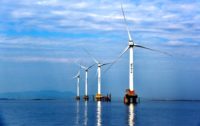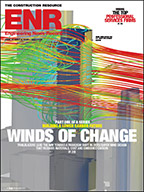...each corner. A full scale mock-up of a turbine assembly was put together at an airfield outside London to test the erection sequence, says Matthew Hewitt, Brookfield’s construction project director.
The props, weighing nearly a tonne each, were craned into place in early March; their turbines are due to follow in the next weeks. Rated at 19 kW each, they are forecast to deliver 50,000 kWh a year in total. But the final economics of the system will need two years’ monitoring, says Esben Jessen, Norwin’s project manager.
Norwin and external consultants have run computer and wind model tests on Strata’s turbines, but no one has experience with a system 140 m above the streets of London, says Jessen.
If the turbines work as designed, the building would attract a government-sponsored feed-in tariff totaling $18,000 a year, says Brookfield’s Black. On that basis, “The estimated payback period for the three wind turbines, manufactured and installed, will be in the region of 18 years,” he adds.
Contender
The economic viability of wind turbines at China National Tobacco Co.’s Pearl River Tower, in Guangzhou, seems less robust.
Performance of the four vertical-axis turbines will take months of live monitoring before their performance can be gauged. However, they are now forecast to contribute 1% to 3% of Pearl River’s electricity needs, says Russell Gilchrist, director of technical architecture in the Chicago office of the project’s architect-engineer, Skidmore, Owings & Merrill LLP.
Among energy-saving and energy-generating measures planned by SOM to achieve zero-energy net consumption at the building were some 50 highly efficient refrigerator-size micro-turbines. But the 3-mW units, burning biogas or fossil fuel, were deemed uneconomical and were eliminated when the local power utility decided not to allow the building to export surplus power through the grid.
Wind turbines on the Pearl River Tower also would have failed the value-for-money test, but the owner ordered them anyway, says Gilchrist. Incorporating wind energy into the building has “symbolic” value, he says.
Two-floor-deep aerodynamic openings in the facade will scoop wind through the 71-story building, on either side of its core, roughly one-third and two-thirds up. The four 6-m-wide openings at the equipment levels will each funnel wind to a 5.8-m-tall, 3-m-dia vertical-axis turbine, supplied by Oy Windside Production Ltd., Viitasaari, Finland.
In terms of energy investment, “there are other things you can do to bring a faster return,” says Gilchrist. For that reason, “I’m not sure if we are going to see a huge [payback],” he says. Norwin’s experience seems to confirm that view. “We have had several other companies contacting us,” says Jessen, but none of the callers has taken the idea any further yet.








Post a comment to this article
Report Abusive Comment